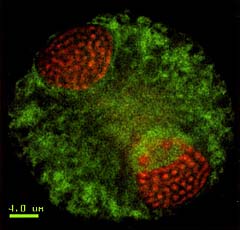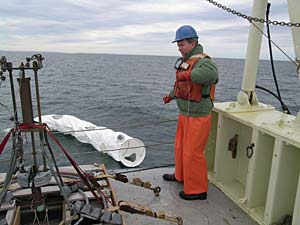Toxic Algae
Air Date: Week of June 17, 2005

An Alexandrium cell (Photo: Kristin Gribble © Woods Hole Oceanographic Institution)
We've been hearing a lot recently about the toxic algae bloom that is fouling ocean waters from Maine to Martha's Vineyard. But what is the organism behind this red tide and how did it get to be such a problem this year? Host Steve Curwood turns to Woods Hole Oceanographic Institution scientist Dennis McGuillicuddy to find out.
Transcript
CURWOOD: It's Living on Earth, I'm Steve Curwood. You've probably heard a lot already about the red tide that's turning clams and mussels from tasty to toxic along the coastline from Maine to Massachusetts. As this toxic algae bloom keeps the shellfishing industry off the clam flats, scientists are digging deep to find out why this year's red tide is so massive. Among them is Dennis McGillicuddy, an expert on the health effects of oceans at the Woods Hole Oceanographic Institution. So Dennis, what's causing this red tide? I understand it's a dinoflagellate, although it has nothing to do with dinosaurs, right?
|
MCGILLICUDDY: (LAUGHS) Nothing at all. Dinoflgellate is a single-celled algae, that uses light energy from the sun and nutrients from the deep sea to carry on the process of photosynthesis. CURWOOD: But in this case, this is something that we don't particularly like. Why? MCGILLICUDDY: As part of the cellular metabolism, this particular dinoflagellate, Alexandrium fundyense, creates a very potent toxin, called saxitoxin, which when accumulated in high enough concentrations, is a serious threat to human health. CURWOOD: How is it that this particular algal bloom grew so fast? MCGILLICUDDY: Well, this is exactly what we are studying at the moment, and it's a little too early to tell for sure, as this bloom is still unfolding before our eyes. But we have three main hypotheses. But to understand these hypotheses, I first need to say a few words about the life cycle of Alexandrium. It's a very complex life cycle for a single-celled algae. CURWOOD: Okay. MCGILLICUDDY: It actually has a benthic cyst stage. That is, it can live in the sediments for period of months, to in excess of years as a resting cyst on the bottom. CURWOOD: The benthic meaning the bottom? MCGILLICUDDY: That's right. And due to an endogenous clock that's present inside the cell, it will begin to germinate in about April or early May of every year. Once the cysts germinate, they swim upward into the light to begin their phase of vegetative growth, when the actual bloom dynamics occur. CURWOOD: So you say that there are three basic notions as to why we have a rapid growth this year. Behind door number one? MCGILLICUDDY: (LAUGHS) Behind door number one is that it appears that the source population, that is the source of benthic cysts, is larger now than it was the last time the cysts were surveyed. There was a very intensive survey of the benthic cyst distribution in the fall of 2004, just this past fall. And the overall finding was that the amount of cysts in the sediments, particularly north of Cape Anne, was much higher than it was the last time those cysts were surveyed back in 1997. CURWOOD: Hmm, okay. And then behind door number two? MCGILLICUDDY: Behind door number two is the fact that transport conditions were favorable in this area to deliver those source populations into Massachusetts and Cape Cod bays. You may remember that there were two very strong Northeaster-type storms here in the coastal ocean in May. Those strong winds out of the North and Northeast tend to channel the currents in the coastal ocean to deliver those source populations into Massachusetts and Cape Cod bays. CURWOOD: And the third prospect here, the third hypothesis?  An Alexandrium cell. (Photo: Kristin Gribble © Woods Hole Oceanographic Institution) |
MCGILLICUDDY: The third hypothesis is that the growth conditions are favorable for the blooming of Alexandrium. Those same Northeaster storms that were responsible for favorable transport may also be responsible for setting up favorable bloom conditions. That is to say, those very strong winds cause a lot of waves and turbulence on the surface ocean. That tends to entrain nutrients from the deep sea into the surface layers, which would then sustain blooms of Alexandrium, as well as other plankton. What remains behind door number three in that there is one other possibility that may have led to favorable growth conditions, and that is that we have much higher than average rain runoff into the coastal ocean. That is, freshwater that is emanating from rivers all up and down the coast. That is much higher than average this year, and that would also tend to deliver nutrients to the coastal ocean and create favorable growth conditions. CURWOOD: Now how come the red tide effects mussels and clams, but not lobsters amd shrimp? MCGILLICUDDY: The reason that shellfish are so effected is because they're like little underwater vacuum cleaners. The typical market-sized mussel is filtering at a rate of ten liters of seawater per hour, 24 hours a day, seven days a week. And so there's an enormous capability for concentration of the toxins that they’re accumulating as they filter the plankton out of the water. Other organisms that don't filter-feed like that simply don't accumulate nearly the concentrations of toxins that the mussels and clams do. CURWOOD: Now I understand that even after this particular red tide goes away from Massachusetts Bay and the Gulf of Maine here along the northeast, that its impacts could be felt for years to come. Why is that? MCGILLICUDDY: The reason for that goes back to the life history strategy of this particular organism. Once the cells face some sort of environmental stress, say like nutrient limitation or temperatures that are too high, or salinities that aren't suitable for their growth, the cells will then go through a phase of sexual reproduction, then form a new cyst and sink down to the bottom. Now those benthic cysts are a way for the organism to persist for years and years to come. Now if as a result of this extraordinarily large and intense red tide, a whole new set of benthic cysts are formed and deposited in new areas, that could lead to serious problems in the coming years. CURWOOD: Dennis McGillicuddy is with the Woods Hole Oceanographic Institution, and is also Deputy Director of the Woods Hole Center for Oceans and Human Health. Dennis, thanks for taking this time with us today. MCGILLICUDDY: It's my pleasure. Living on Earth wants to hear from you!Living on Earth Newsletter [Click here]
Donate to Living on Earth! NewsletterLiving on Earth offers a weekly delivery of the show's rundown to your mailbox. Sign up for our newsletter today!
|






